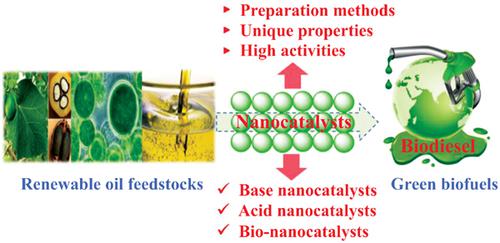Current Nanoscience ( IF 1.5 ) Pub Date : 2020-05-31 , DOI: 10.2174/1573413715666190411142820 Hu Pan 1 , Hu Li 1 , Heng Zhang 1 , Anping Wang 1 , Song Yang 1

|
Background: Biodiesel, as a green and renewable biofuel, has great potential to replace fossil diesel. The development of efficient and stable heterogeneous catalysts is vital to produce biodiesel in an efficient and green way. Nanocatalysts provide a high surface-to-volume ratio as well as high active site loading and can improve mass transfer, which is beneficial to enhance their catalytic activity.
Objective: The review focuses on the latest advances in the production of biodiesel using nanostructured catalysts.
Methods: Biodiesel is mainly produced through esterification and transesterification reaction using acids, bases or lipases as catalysts. We mainly review the synthesis methods and physicochemical properties of various basic, acidic and lipase nanocatalysts. Meanwhile, their catalytic activities in biodiesel production are also discussed.
Results: Alkali nanocatalysts are mainly suitable for transformation of oils with low acid values to biodiesel via transesterification reaction. In contrast, acidic nanocatalysts are not sensitive to water as well as free fatty acids and can avoid saponification associated with basic nanocatalysts while promote simultaneous esterification and transesterification reaction. However, acid-catalyzed transesterification usually requires harsh reaction conditions. In addition, the lipase-catalyzed process is also suitable for non-edible oils containing high contents of free fatty acids, which possess environmental and economic advantages.
Conclusion: Nanocatalysts have many advantages such as good accessibility with nanostructure, high active site loading and reduction of mass transfer resistance. However, most of those materials undergo deactivation after several cycles. Therefore, the development of more efficient, stable, and low-cost nanocatalysts is desirable for producing biodiesel.
中文翻译:

功能纳米材料催化的生物柴油生产
背景:生物柴油作为一种绿色和可再生的生物燃料,具有替代化石柴油的巨大潜力。开发高效稳定的多相催化剂对于以高效绿色的方式生产生物柴油至关重要。纳米催化剂提供高的表面体积比以及高的活性位点负载,并且可以改善传质,这有利于增强其催化活性。
目的:这篇综述着重于使用纳米结构催化剂生产生物柴油的最新进展。
方法:生物柴油主要通过酸,碱或脂肪酶为催化剂进行酯化和酯交换反应制得。我们主要综述了各种碱性,酸性和脂肪酶纳米催化剂的合成方法和理化性质。同时,还讨论了它们在生物柴油生产中的催化活性。
结果:碱纳米催化剂主要适合通过酯交换反应将低酸值的油转化为生物柴油。相反,酸性纳米催化剂对水以及游离脂肪酸不敏感,并且可以避免与碱性纳米催化剂相关的皂化,同时促进同时的酯化和酯交换反应。然而,酸催化的酯交换反应通常需要苛刻的反应条件。此外,脂肪酶催化的方法也适用于含有高游离脂肪酸含量的非食用油,这些油具有环境和经济优势。
结论:纳米催化剂具有许多优点,例如具有良好的纳米结构可及性,高的活性位点负载和降低的传质阻力。但是,大多数这些材料在几个循环后会失活。因此,需要开发更有效,稳定和低成本的纳米催化剂来生产生物柴油。


























 京公网安备 11010802027423号
京公网安备 11010802027423号